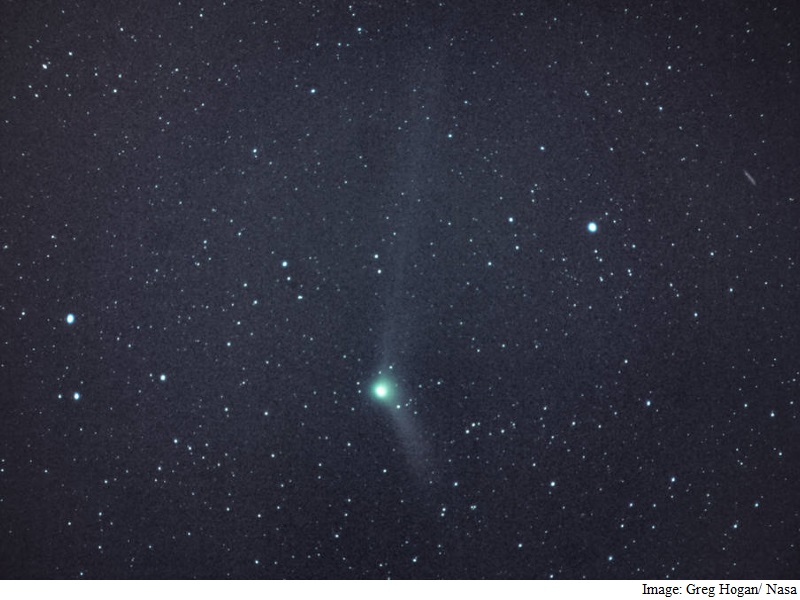- Home
- Science
- Science News
- Wish Happy New Year 2016 to Rare Comet on January 1
Wish Happy New Year 2016 to Rare Comet on January 1

Comet Catalina, formally known as "C/2013 US10", is currently perched in the pre-dawn skies as it returns to the depths of space following a recent visit to the inner part of our solar system, Nasa said in a statement.
At minimum, binoculars are required to view the comet which will appear as a fuzzy envelope of ice and dust, known as a coma.
Perhaps the simplest way to find Comet Catalina is to first locate the "Big Dipper" in the pre-dawn sky.
Note how the handle forms a sort of "arc".
That "arc" can be followed to the orange giant star known as Arcturus which, for those in the Northern Hemisphere, is the second brightest star in the sky and relatively easy to identify.
On New Year's day, the comet will pass a mere 0.5 degrees - about the width of the moon - to the west of Arcturus.
So if you head outdoors 60-90 minutes before dawn, let Arcturus serve as your guide to find the faint, fuzzy patch of Comet Catalina.
"Of course, for optimal viewing, it's recommended that you observe away from streetlights and city skyglow," the statement read.
If you miss Comet Catalina, don't despair. You can still be treated to an alternate planetary extravaganza in the morning sky where Venus gleams in the southeast.
Just before dawn on New Year's Day, Saturn will be about eight degrees to the lower left of Venus. By January 4, the pair will appear even closer together.
On January 6 and 7, the waning crescent moon slips by the planetary pair.
And on the morning of January 8, Venus and Saturn are separated by a mere 0.4 degrees (less than one moon-width).
The celestial dance continues through January so that near month's end, the five planets known as the "ancients" span the sky from the southeast to the southwest in the morning twilight.
In order (across the southern sky), these are Mercury, Venus, Saturn, Mars and Jupiter.
For the latest tech news and reviews, follow Gadgets 360 on X, Facebook, WhatsApp, Threads and Google News. For the latest videos on gadgets and tech, subscribe to our YouTube channel. If you want to know everything about top influencers, follow our in-house Who'sThat360 on Instagram and YouTube.
- Amazon Great Indian Festival 2024
- Big Billion Days 2024
- Apple Vision Pro
- Oneplus 12
- iPhone 14
- Apple iPhone 15
- OnePlus Nord CE 3 Lite 5G
- iPhone 13
- Xiaomi 14 Pro
- Oppo Find N3
- Tecno Spark Go (2023)
- Realme V30
- Best Phones Under 25000
- Samsung Galaxy S24 Series
- Cryptocurrency
- iQoo 12
- Samsung Galaxy S24 Ultra
- Giottus
- Samsung Galaxy Z Flip 5
- Apple 'Scary Fast'
- Housefull 5
- GoPro Hero 12 Black Review
- Invincible Season 2
- JioGlass
- HD Ready TV
- Laptop Under 50000
- Smartwatch Under 10000
- Latest Mobile Phones
- Compare Phones
- Vivo Y18t
- Honor X9c
- Honor Magic 7 Pro
- Honor Magic 7
- Sharp Aquos R9 Pro
- Xiaomi 15
- Xiaomi 15 Pro
- Redmi A3 Pro
- Asus Zenbook S 14
- MacBook Pro 16-inch (M4 Max, 2024)
- Huawei MatePad 11.5
- Acer Iconia Tab 10.36 (iM10-22)
- Redmi Band 3
- Xiaomi Smart Band 9 Pro
- Sony 65 Inches Ultra HD (4K) LED Smart TV (KD-65X74L)
- TCL 55 Inches Ultra HD (4K) LED Smart TV (55C61B)
- Sony PlayStation 5 Pro
- Sony PlayStation 5 Slim Digital Edition
- Acer 1.5 Ton 5 Star Inverter Split AC (AR15AS5INGMA)
- Daikin 1.5 Ton 4 Star Inverter Split AC (FTKT50UV16V+RKT50UV16V)












